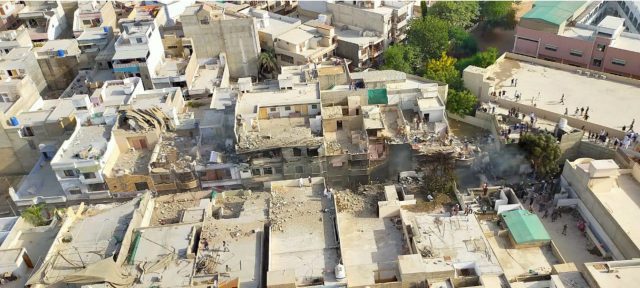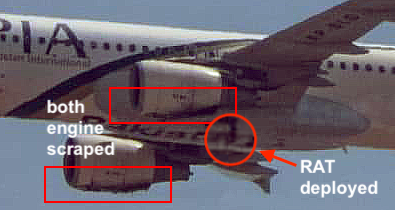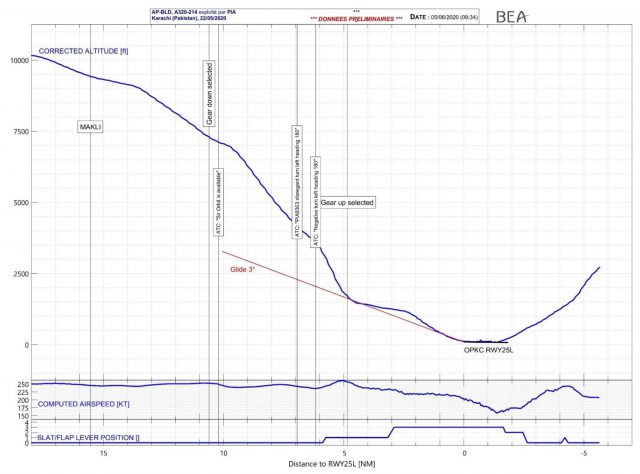PIA Pakistan Airlines flight PK8303 crashed short of a runway in Karachi Airport, over a residential area, on May 22, 2020.

PIA Pakistan Airlines flight PK8303 crasi site
It was a domestic flight from Lahore and it was operated with an Airbus A320-214 registration AP-BLD.
99 people were on board, 2 passengers survived while 97 on board including 8 crew members died in the crash; additional fatalities on ground are unconfirmed.
According to the initial evidences, the crew was high on profile and struggling to descent and land: they reported descending from 3500 to 3000 ft AAL while 5 NM on final.
The following are the crew / ATC recordings where the PM (pilot monitoring) is heard saying “we are comfortable (?), we can make it“.
When being cleared to land, a “Master warning” can be heard during a crew transmission.
Following facts were highlighted in the interim report issued by the AAIB Pakistan :
- (a) The reported weather at origin, en-route and at destination airfields was fit to undertake the flight.
- (b) On 22 May 2020 PIA flight PK8303 took off from AIIAP Lahore at 13:05 hrs (as per the Lahore ATC recording / transcript). Departure from Lahore and cruising flight were uneventful. The crew did not follow standard callouts and did not observe CRM aspects during most parts of flight.
- (c) “Area Control Karachi East” cleared PK8303 for “Nawabshah 2A” arrival procedure (STAR – Standard Terminal Arrival Route as published in AIP and JEPPESEN), and advised to expect ILS approach for runway 25L. The flight was later cleared at pilot’s discretion to report direct MAKLI (a waypoint 15 nautical miles at a radial of 075 from Karachi VOR) and descend to FL100, and later re-cleared for FL50.
The aircraft changed over to “Karachi Approach” and was cleared to descend down further to 3000 ft, by the time it reaches MAKLI. - (d) The aircraft ended up higher than the required descend profile.
At MAKLI the aircraft was at 9780 ft and at about 245 knots IAS. In order to manage the descent and lose the additional height, “OPEN DES” mode was selected via the FCU, both autopilots were disengaged and speed brakes were extended.
(e) “Karachi Approach” inquired “confirm track mile comfortable for descend” and later advised to take an orbit, so that the aircraft can be adjusted on the required descend profile. No orbit was executed and the effort to intercept the glide slope and localizer (of ILS) was continued. The FDR indicated action of lowering of the landing gears at 7221 ft at around 10.5 Nautical Miles from Runway 25L.
(f) “Karachi Approach” advised repeatedly (twice to discontinue the approach and once cautioned) about excessive height. Landing approach was not discontinued. However, FDR shows action of raising of the landing gears at 1740 ft followed by retraction of the speed brakes (at a distance slightly less than 05 nautical miles from the runway 25L). At this time, the aircraft had intercepted the localizer as well as the glide slope.
Flaps 1 were selected at 243 knots IAS, the landing gears and speed brakes were retracted.
Over-speed and EGPWS warnings were then triggered.
(g) Figure hereunder depicts a few parameters of FDR data and the first approach profile of the aircraft in comparison with the required approach profile.
Note : For the descent path, the altitude has been shifted to start from 84 ft in order to match the altitude of the runway at ground impact.
- (h) Since the approach to land was continued, “Karachi Approach” instead of changing over the aircraft to “Aerodrome Control”, sought telephonic landing clearance from the “Aerodrome Control”.
The “Aerodrome Control” conveyed a landing clearance of the aircraft (without observing the abnormality that the landing gears were not extended) to “Karachi Approach”. Subsequently “Karachi Approach” cleared the aircraft to land.
At 500 ft, the FDR indicates: landing gear retracted, slat/flap configuration 3, airspeed 220 knots IAS, descent rate 2000 ft/min. According to the FDR and CVR recordings several warnings and alerts such as over-speed, landing gear not down and ground proximity alerts were disregarded.
- (i) The landing was undertaken with landing gears retracted. The aircraft touched the runway surface on its engines. Flight crew applied reverse engine power and initiated a braking action. Both engines scrubbed the runway at various locations causing damage to both of them. Figures show selected screenshots of security / CCTV cameras footages of the aircraft engines touching the runway and showing sparks due to scrubbing, along with marks on the runway.
- The “Aerodrome Control” observed the scrubbing of engines with the runway but did not covey this abnormality to the aircraft. It was conveyed to the “Karachi Approach” on telephone. Subsequently “Karachi Approach” also did not relay this abnormality to the aircraft.
- (k) The landing was discontinued and a go-around was executed. FDR recording indicates a brief action of selection of landing gear lever to down position, which was immediately followed by its movement to up position.
Intention to undertake another ILS approach for landing on runway 25L was conveyed, however shortly after the go-around both engines failed one by one. Ram Air Turbine (RAT) was deployed to power the essential systems. FDR data recording stopped during this timeframe (as per the designed limitation).
The aircraft was unable to maintain required height. The aircrew declared the emergency situation that both engines were lost, and transmitted a “Mayday Call”. Evidences from the wreckage indicate reasons for right engine failure, however left engine requires further examination, and landing gear in extended position did not demonstrate any malfunction of the landing gear system. - (l) The aircraft crashed about 1340 meters short from runway 25L. It was a slow speed impact with high angle of attack, with aircraft configuration indicating landing gears extended, slats at step / position 1, and flaps retracted.
The said configuration was ascertained and documented from the wreckage at the crash site (as the FDR data recording had stopped earlier). - (m) The aircraft was reportedly serviceable for the said flight; necessary scrutiny of the aircraft maintenance records / documents is under way. Captain and First Officer were adequately qualified and experienced to undertake the said flight; necessary scrutiny of the aircrew records / documents is under way.



Hi, it was a very sad accident, the photos showed effectively the damaged bottom on both engines.
On those kind of turbines the accesories boxes are precisely on the bottom of the part damaged.
And the runway inspection in Karachi´s runway, showed twice traces in two different moments of the G/A procedure.
That means that the turbines were hit very hard and probably the fuel pumps, hydraulic pumps and generator on both engines were hit onthe event of G/A.
Rest in peace All!
Luis, I don’t agree with gearbox thing because gearbox of A320 is approximately at 45* angle and the fuel pumps are all above the engines. The only thing which can damage the engine is oil sump. On impact, they may have damaged the oil sump and they kept on leaking the oil until both engine seized. The black spot on runway and beneath the engines are of oil. One can clearly see the oil marking beneath the engine exactly after drain pipe of cowling.
very well informative post
This is a very common with PIA pilot I have already discussed this Captain ***** .
Google AP AYW B747 282 – Gear up landing – 1986.
I think it’s the same set senioro with the A320
Hi Ahmed,
it would be interesting to read the final report of this PIA B747 belly landing: we will work on this, thank you !
https://historyofpia.com/acciphoto.htm
My verdict ; captain syed
Gul and his co pilot forgot
To put the gear down .
What do expect in a world where authority ,regulation and law and order are being abused and discarded in the name of woke, racism or whatever. Just look at America now. From the very beginning in aviation it is impressed upon crews to admit it when they mess up and take correcting action early. Some cultures have a loss of face aspect and so don’t admit messing up and therefore are not suitable for some industries. ie aviation.
I was in Pakistan when B747 landed belly landed at Old Islamabad airport , one of my friend was in that a/c and he said “landing was very smooth but then i saw engine cowling was fling around at Runway. ”
if I remember correctly Captain and co pilot forget to put the landing gear down because they completed check list but ATC did not give clearance to land due to Cessna was flying low level. Captain decided to complete the check list without doping the landing gear and ask to pull CB out to bypass the warning and when ATC give clear to land they forget to push the lever down at last minute releasing mistake push the lever down but it was too late, only Nose landing gear door open. I think No body got any injury. I learn from
news story and from Friends so i do apology if i quoted something which is not true.
Rayhan, it seems like you have some problem with PIA pilots. I have seen ur comments on other forums also. Plz talk like a professional. What do you know about A320?? What is CRM to a crew?? Is CRM only for pilots?? Grow up and give suggestions to improve aviation safety. If you are so interested in investigations and giving your opinion on everything then take out the crash history of military a/c’s that includes all three forces and then blame them for their technical as well as human error.
40% of PIA pilots have fake licenses ! No surprise such accidents to happen ! The last approach was anything but normal ! high pitch , high speed ! high altitude ! GPWS warnings were totally disregarded, in addition to that ATC was ignored !!!
One of the best website and amazing, content i am much impressed by it well there is a lots of information about it
Is this the only case that a Go-around is performed on a commercial airliner, or any type of jet whatsoever, subsequent to a Belly-landing? Simply unimaginable.
Although this sounds queer, it indeed happened before: in 1996 an Iran Air’s B727 (EP-IRU) landed at airport in Rasht, Iran with its landing gear not extended because of pilot negligence. Crew of this training flight made a go-around, too; however, the contact with ground ignited a fire on board, which rendered the plane hard to control. Eventually the plane crash-landed in a rice field, killing four of the seven people on the flight.